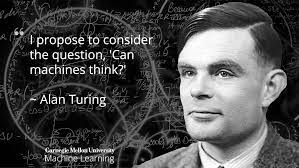
HIGHLIGHTS
“I propose to consider the question, ‘Can machines think?'”.
Alan Mathison Turing was one of the most important scientists of the twentieth century and made significant contributions to the fields of mathematics, computer science, and artificial intelligence. He received his undergraduate degree in mathematics from King’s College in Cambridge in 1934 and was made a fellow of the college in 1935.
In 1936, Turing published his revolutionary essay “On Computable Numbers, with an Application to the Entscheidungsproblem.” It was published in the Proceedings of the London Mathematical Society in two parts, the first on 30 November and the second on 23 December 1936. Here he introduced the idea that one might construct a universal machine capable of simulating any other machine. His theoretical machine could solve any problem that could be described by simple instructions encoded on a paper tape. One Turing Machine might calculate square roots, and another might solve logic puzzles. Turing postulated the construction of a single Universal Machine that could be designed to simulate any Turing Machine. His Universal Turing Machine idea served as the basis for the first computer.
“There will positively be no internal alteration to be made even if we wish suddenly to switch from calculating the energy levels of the neon atom to the enumeration of groups of order 720. It may appear somewhat puzzling that this can be done. How can one expect a machine to do all this multitudinous variety of things? The answer is that we should consider the machine to be doing something quite simple, namely carrying out orders given to it in a standard form which it is able to understand.” – Alan Turing
He returned to Cambridge in 1938 after completing his doctoral thesis at Princeton. In 1939 Britain declared war on Germany, and recruited Turing to join the team of British code breakers at Bletchley Park near London. While working as a British codebreaker, Turing designed an electromechanical machine called the “Bombe.” The giant apparatus was able to calculate the day key from approximately 1,054,560 possible values using “cribs.” By using hundreds of these “Bombes” in the United Kingdom and the United States, the Allied Forces were able to decode Nazi forces radio messages within a few minutes. The codes generated from the method of encryption of the German Enigma device, invented 20 years earlier, were previously deemed unbreakable. After the end of World War II, President Eisenhower wrote to thank the codebreakers at Bletchley for intelligence of “priceless value” that “saved thousands of British and American lives and, in no small way, contributed to the speed with which the enemy was routed and eventually forced to surrender.”
In 1948, Turing began working at Manchester University’s computing laboratory. There he published another groundbreaking paper called “Computing machinery and intelligence” (1950), where he proposed that computing machines would become so powerful that they would think. He developed what is now known as the Turing test, which tests the ability of a designed machine to exhibit behavior equivalent to that of a human. The test involved a machine designed to generate human-like responses when subjected to certain questions, with the responses then evaluated by a human. Turing postulated that the participants’ responses would be limited to text, and that a machine passes the test when it successfully generates responses appropriate enough to convince the evaluator that it is human. The test placed no emphasis on correct answers, only whether the machine responses were human-like.
In 1952, Turing was prosecuted in the United Kingdom for homosexual acts. He pled guilty and accepted chemical castration as an alternative to prison. In 2009, the Prime Minister of the United Kingdom apologized and four years later Turing received a posthumous pardon. In 2017, “Turing’s Law” went into effect and has resulted in pardons for thousands of other convicted gay and bisexual men in the United Kingdom.
Author: Jennell C. Bilek
More info here: WW2 Codebreakers: Bletchley Park activities revealed in unique footage – The Hidden Film – YouTube
To learn more about Carlson Caspers’ commitment to Diversity & Inclusion, click here.
To apply for the Carlson Caspers Diversity & Inclusion Scholarship and meet past recipients, click here.
To learn about Carlson Caspers’ engagements with organizations committed to diversity and inclusion in the legal profession, click here.
To learn about other featured inventors, click here.
PATENTS
US Patent No. 2,799,449
